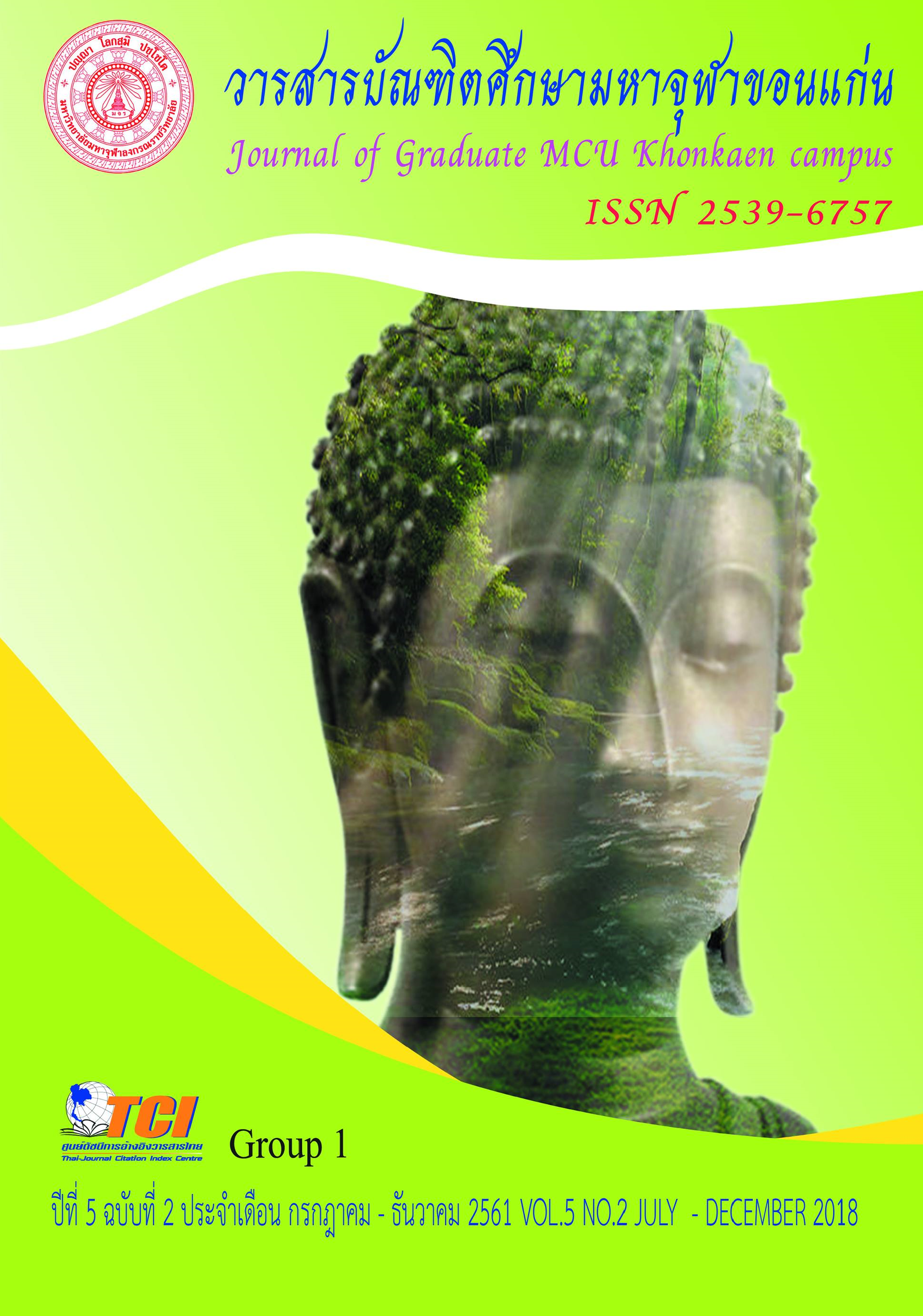การพัฒนาคุณภาพชีวิตตามหลักศีล 5 ของบุคลากรทางการศึกษาสังกัดสำนักงานเขตพื้นที่การศึกษามัธยมศึกษา ในภาคตะวันออกเฉียงเหนือตอนบน
Main Article Content
Abstract
การวิจัยครั้งนี้มีวัตถุประสงค์ คือ 1) เพื่อศึกษาสภาพการดำเนินชีวิตด้วยหลักศีล 5 ของบุคลากรทางการศึกษาในภาคตะวันออกเฉียงเหนือตนบน 2) เพื่อสร้างรูปแบบการพัฒนาคุณภาพชีวิตด้วยหลักศีล 5 ของบุคลากรทางการศึกษาในภาคตะวันออกเฉียงเหนือตอนบน 3) เพื่อประเมินผลรูปแบบการพัฒนาคุณภาพชีวิตด้วยหลักศีล 5 ของบุคลากรทางการศึกษาในภาคตะวันออกเฉียงเหนือตอนบนประชากรที่ใช้ในการวิจัยคือ บุคลากรทางการศึกษาและผู้เกี่ยวข้อง จำนวน 466 คน เครื่องมือที่ใช้เป็นแบบสัมภาษณ์ แบบสนทนากลุ่มเฉพาะ และแบบสอบถาม การวิเคราะห์ข้อมูลใช้การวิเคราะห์เนื้อหาประกอบบริบท ค่าเฉลี่ย และส่วนเบี่ยงเบนมาตรฐาน
ผลการวิจัย พบว่า 1. สภาพการดำเนินชีวิตด้วยหลักศีล 5 ของบุคลากรทางการศึกษาในภาคตะวันออกเฉียง เหนือตนบนใน 4 ด้าน คือ 1) สภาพการทำงาน พบว่า บุคลากรทางการศึกษามีความปรองดองสมานฉันท์ลดความขัดแย้งการมีสันติสุขการมีสัมมาชีพ/อาชีพสุจริตมีศีลธรรมและวัฒนธรรมมีสุขร่มเย็นและสันติสุขมีสามัคคีธรรมมีการเสริมสร้างความเข้าใจที่ดีมีความซื่อสัตย์สุจริตมีสุขภาพอนามัยดีมีสาธารณสงเคราะห์ 2) การประยุกต์ใช้หลักศีล 5 ในการดำเนินชีวิต พบว่า การลดเหตุทะเลาะวิวาทกันในที่ทำงานประหยัดไม่ฟุ่มเฟือยไม่ลวงประเวณีคู่ครองหรือคนอื่นในปกครองของคนอื่นจริงใจต่อกัน มีสติสัมปชัญญะในการทำงาน 3) ปัญหาในการดำเนินชีวิต พบว่า ขาดความยุติธรรมในการบริหารจัดการใช้สิ่งของและทรัพยากรทางราชการอย่างฟุ่มเฟือยครอบครัวแตกแยกอันเนื่องมาจากผิดประเวณีขาดความจริงใจในการคบมิตรทำงานโดยขาดความรอบคอบ 4) ข้อเสนอแนะในการดำเนินชีวิต พบว่า ควรจัดกิจกรรมสร้างสันติสุขในองค์กร สร้างจิตสำนึกในการประหยัดต้องประพฤติตนเป็นคนอ่อนน้อมถ่อมตนควรสร้างความเข้าใจที่ดีต่อกัน และควรแสดงความเอื้อเฟื้อเผื่อแผ่
2. รูปแบบการพัฒนาคุณภาพชีวิตด้วยหลักศีล 5ของบุคลากรทางการศึกษาในภาคตะวันออกเฉียงเหนือตนบน พบว่า มี 4 รูปแบบคือ 1) รูปแบบการพัฒนาคุณภาพชีวิตด้วยหลักศีล 5 ด้านกาย มี 23 ตัวชี้วัด 2) รูปแบบการพัฒนาคุณภาพชีวิตด้วยหลักศีล 5 ด้านจิตใจมี 19 ตัวชี้วัด 3) รูปแบบการพัฒนาคุณภาพชีวิตด้วยหลักศีล 5 ด้านสังคม มี 18 ตัวชี้วัด 4) รูปแบบการพัฒนาคุณภาพชีวิตด้วยหลักศีล 5 ด้านสิ่งแวดล้อมมี 17 ตัวชี้วัด
3) ผลการประเมินรูปแบบการพัฒนาคุณภาพชีวิตตามหลักศีล 5 ของบุคลากรทางการศึกษาสังกัดสำนักงานเขตพื้นที่การมัธยมศึกษาในภาคตะวันออกเฉียงเหนือตอนบน พบว่า มีความพึงพอใจอยู่ในระดับมาก
The purpose of this research was 1) to study the living conditions of the 5 precepts of educational personnel in the northeastern region; 2)To develop the model of quality of life development through the 5 precepts of educational personnel in the region. 3) To evaluate the development of quality of life through the 5 precepts of educational personnel in the Northeastern region. The research population was 466 personnel and related persons. Specific group discussion and data analysis questionnaires used content analysis, context, mean, and standard deviation.
The research found that: 1. The living conditions of the 5 precepts of educational personnel in the Northeastern region were: 1) The working condition was that the educational personnel were reconciled to reduce conflict, peace. Having good conductors / morals, morality and culture, having peace and tranquility, having a good fellowship, good understanding, honesty, good health and good health. 2) The application of the 5 precepts in the way of life, it is found that the reduction of spat in the workplace, save money, no luxuries, no banquet for the spouses or other people in the ruling of others sincere against each other. 3) Problems in the way of life, lack of justice in the management of the use of resources and the government, luxuries, broken families due to the misconduct, lack of sincerity in the friendship, work, lack of prudence.). Suggestions for living should be held to create peace in the organization. Consciousness in saving must behave as a humble person should create a good understanding of each other. And should show generosity.
The development of the quality of life through the 5 precepts of educational personnel in the Northeastern region was found to be in four forms: 1) the development of the quality of life through the five precepts, 5 physical aspects, 23 indicators The development of the quality of life through the five precepts of the mind, the mind has 19 indicators. 3) The development of the quality of life by the five precepts. The social aspect has 18 indicators. 4) The development of quality of life with the five precepts. thing The environment contains 17 indicators. 3) The results of the assessment of the quality of life development in accordance with the precepts 5 of educational personnel under the office of secondary education in the upper northeastern region showed that the satisfaction level was very high.

